
Priest's defense rests case; closing arguments next
5/9/2006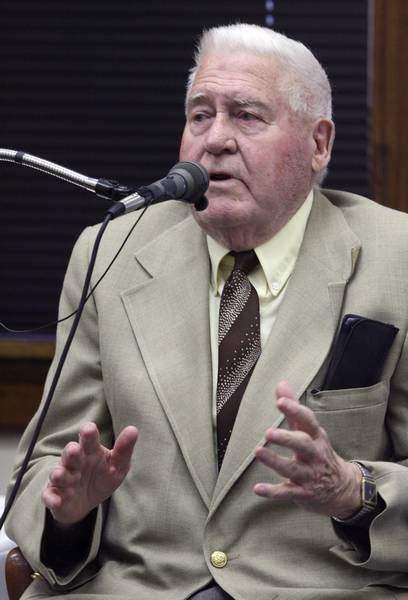
Retired Toledo police Deputy Chief Ray Vetter.
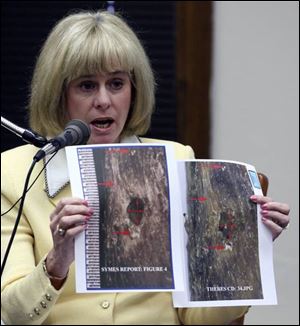
Forensic pathologist Kathleen Reichs testified that inserting a letter opener into the wound in Sister Margaret's jaw could have contaminated the evidence.
The Rev. Gerald Robinson's defense rested yesterday after calling 11 witnesses in two days, probing police and forensic experts to build its case that there is insufficient evidence to convict the priest of murder.
Father Robinson is charged in the 1980 slaying of Sister Margaret Ann Pahl, who was choked to the verge of death, then stabbed 31 times on Holy Saturday in the sacristy of the former Mercy Hospital. Prosecution witnesses in the case in Lucas County Common Pleas Court have testified it was a ritual killing, the first nine stab wounds were in the near-perfect shape of an upside-down cross, and the wounds were allegedly made by the priest's medallion letter opener.
Closing arguments are set for tomorrow, after which the 12 jurors will begin their deliberations. Jurors, who must reach a unanimous verdict, will not be sequestered except when deliberating.
Judge Thomas Osowik said he generally does not keep ju-rors past 8 p.m. If they have not reached a verdict by then, they will go home and resume at 9 a.m. the next day, even through the weekend.
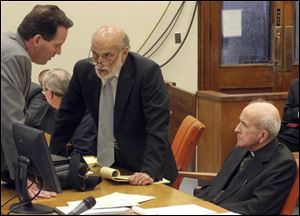
Defense attorneys John Thebes, left, and Alan Konop confer as the Rev. Gerald Robinson listens during his trial for murder.
If Father Robinson is convicted, Judge Osowik could immediately impose the mandatory sentence of life in prison. There is no death penalty in the case because Ohio did not have capital punishment when the slaying occurred.
Defense witnesses who testified yesterday included Ray Vetter, the now-retired Toledo deputy police chief who was in charge of the 1980 murder investigation; four forensic scientists, including Kathleen Reichs, a North Carolina forensic pathologist whose writings inspired the Fox TV show Bones, and a Toledo audio expert who enhanced a police interrogation of Father Robinson that was taped April 23, 2004, after his arrest by cold-case detectives.
Ms. Reichs said she reviewed photos and reports of the case, including photographs of Sister Margaret Ann's body after it was exhumed in May, 2004.
Dr. Diane Barnett of the Lucas County coroner's office testified previously that tests showed the tip of the letter opener was a "perfect fit" in the jawbone wound.
Ms. Reichs said that such tests should not have been conducted on the body to see if Father Robinson's saber-shaped letter opener fit some of the nun's wounds. Inserting the metal blade of the letter opener into her fragile bones could have caused damage to the bone, she said.
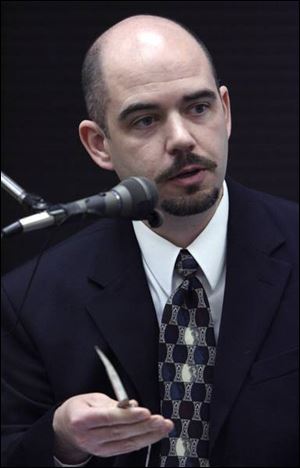
Forensic expert Daniel Davison
A fracture or other damage caused to the indentation on the jawbone - variously reported as only 2 millimeters by 2mm wide or 3mm by 2mm - could have contaminated the evidence, Ms. Reichs said.
Under cross-examination by Chris Anderson, assistant Lucas County prosecutor, Ms. Reichs acknowledged that her court testimony yesterday was the first time she based her conclusions on reviews of photos and reports, without any direct examination of evidence.
Defense attorneys said they were not notified of Sister Margaret Ann's exhumation until after the nun's body was reburied, and therefore were unable to have experts oversee the prosecution's tests nor to conduct their own research.
Forensic scientist Daniel Davison of the Ohio Bureau of Criminal Identification and Investigation testified that a hair discovered in the hallway near the chapel in Mercy Hospital was not a match to Father Robinson's hair. He said his bureau examined the altar cloth and the letter opener, along with the hair.
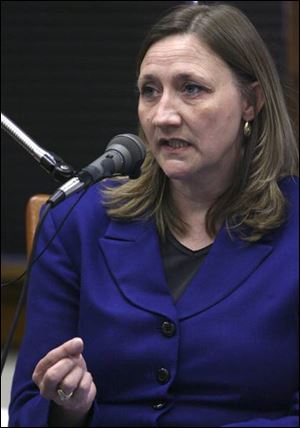
Meghan Clement of LabCorp.
A major part of the prosecution's case was based on experts, including noted forensics investigator Henry Lee, saying that the priest's distinctively shaped letter opener could have been used to kill Sister Margaret Ann.
Toledo police detectives had suggested Friday that Deputy Chief Vetter, 82, had possibly aided the Toledo Catholic Diocese in covering up that Father Robinson was the prime suspect in 1980.
Retired police Detective Arthur Marx, called by the defense Friday, testified that the deputy chief was a "strict Catholic" who ordered all police reports, in triplicate, be sent to his office if they involved Sister Margaret Ann's murder.
Detective Marx and retired Lt. William Kina also said that Deputy Chief Vetter and Msgr. Jerome Schmit came to the Safety Building on April 19, 1980, and that they cut short a police interrogation of Father Robinson.

Retired Toledo police Deputy Chief Ray Vetter.
Deputy Chief Vetter, who retired in 1986, said yesterday that he did not recall halting any interviews of the priest nor did he remember ordering all copies of police reports in the case to be turned over to him.
While acknowledging he is a Catholic, he asserted that "my job came first."
The deputy chief said he brought the monsignor downtown on April 19 to help in the police investigation.
"I was a close personal friend of Monsignor Schmit," Deputy Chief Vetter said. "He told me, 'If ever I can help you in a case, just give me a call.' And so I thought, 'Well, this is a good time to take him up on it.'
"I told him, 'All I want you to do is talk with Father Robinson, make him feel sort of at home. Whatever you can find out, and if you find out anything, let's talk.' And monsignor said he'd be glad to do it," Mr. Vetter said.
The deputy chief called Sister Margaret Ann's murder "a very important case, probably the most notorious one we ever had while I was in the police department."
Nevertheless, Mr. Vetter said that "after about a week or two after the crime, we decided we'd gone about as far as we could go" with the investigation.
He acknowledged under cross-examination that Father Robinson was the only prime suspect in 1980, but after meeting with Curt Posner, a Lucas County assistant prosecutor at the time, they felt there was insufficient evidence to arrest and convict the priest.
An audio expert, Calen Bruce, testified yesterday that he enhanced the audio version of a taped police interrogation of Father Robinson in 2004.
A segment of the tape, recorded after a detective left and while the priest was alone in the room whispering to himself, was played for jurors, but the enhanced version remained difficult to decipher.
Three other defense witnesses testified yesterday about trace evidence, including reports about small amounts of DNA found in Sister Margaret Ann's underwear and fingernails. Forensic scientist Meghan Clement of LabCorp, testified yesterday that the DNA samples from the underwear and fingernails contained a male chromosome that could not have been from Father Robinson.
But the DNA material could have come from contact with a number of people, they said under cross-examination, including emergency medical personnel at the crime scene, lab technicians, or men who transported the nun's body.
Contact David Yonke at:
dyonke@theblade.com
or 419-724-6154.